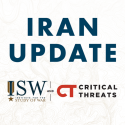Iran Update, October 23, 2023
Oct 23, 2023 - ISW Press
Iranian officials and media are continuing their attempts to deter an Israeli ground operation into the Gaza Strip while also attempting to reassure their domestic and Axis of Resistance audiences that such an operation will fail. IRGC-affiliated Tasnim News Agency outlined the “significant challenges” that Israel will face in conducting a ground operation into the Gaza Strip, highlighting Hamas’ anti-tank capabilities. Iranian state media similarly argued that Israeli Prime Minister Benjamin Netanyahu’s senior advisers fear Hamas and further outlined several “challenges” facing Israeli ground operations into the strip, including declining public support, weakened relations with the Arab world, a high military death toll, and the potential for a geographic expansion of the conflict. IRGC Deputy Commander Brigadier General Ali Fadavi similarly warned that Israel would suffer a “disgraceful” defeat at the hands of the Palestinian resistance were it to enter the Gaza Strip during an interview IRGC-affiliated Fars News Agency.










